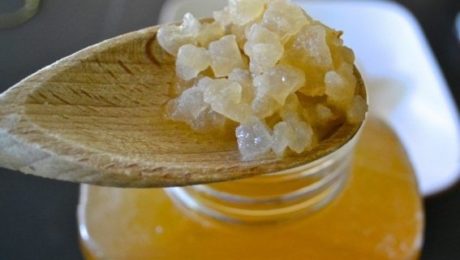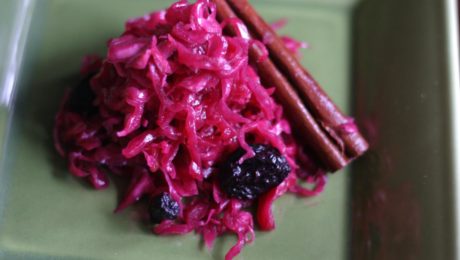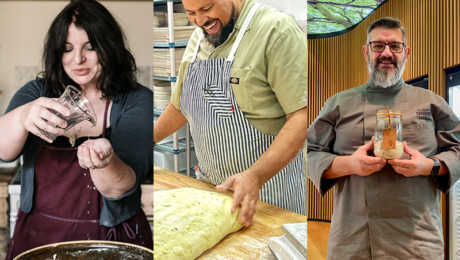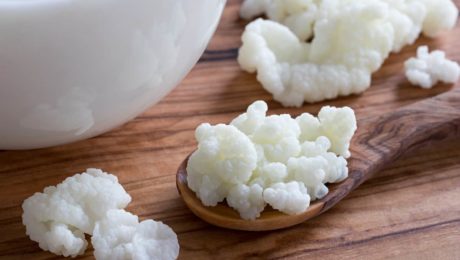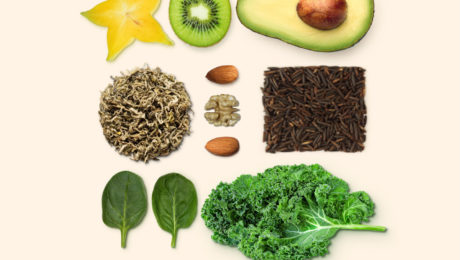The Trending Nordic Diet
For nearly two decades, the Mediterranean diet has been the food choice recommended by dietitians and the USDA.. This approach to eating has been proven to improve health and reduce risk of chronic disease.
But there’s a new contender: the Nordic diet.
This plan focuses on eating fermented foods and beverages, with less meat and more legumes than in the Mediterranean diet. Both approaches are plant-based and full of lean proteins, complex carbs and healthy fats.
“The nordic diet really does promote a lifelong approach to healthy eating,” says Valerie Agyeman, RDN (pictured). “It also really really focuses on seasonal, local, organic and sustainably sourced whole foods that are traditionally eaten in the Nordic region.”
Agyeman, founder of Flourish Heights, shared her research during a Today’s Dietitian webinar “Breaking Down the Nordic Diet: Why is it Gaining So Much Popularity?” The presentation was designed to help registered dietitians better counsel clients on healthy eating habits.
What is Nordic Eating?
The diet embraces traditional Nordic cuisine, with a focus on ingredients that are fresh and local. The core of the fare is from Sweden, Norway, Denmark, Finland and Iceland.
“Fresh, pure and earthly are the words used to describe this food movement that was born out of the landscape and culture,” Agyeman says. “The Nordic movement is all about using what is available.”
The goal is not to invent a new cuisine, but to get back to its roots. Seafood is central, but meat – scarce during the long Nordic winters – is treated as a side dish Fresh vegetables and berries – the most common Nordic fruit – are prevalent during the summer. Fermented foods were born out of the necessity to preserve food from the warmer months to eat during winter. The indigenous Nordic people traditionally fermented vegetables, fish and dairy.
“It really takes the focus off calories and puts it on healthy food,” Agyeman adds. “This way of eating is pretty nutrient-dense.”
Nordic foods, she continues, are served in their natural state with minimal processing. They’re high in antioxidants, prebiotics, probiotics, fiber, minerals and vitamins; low in saturated fats, trans fats, added sugars and added salts.
“The Nordic diet is really not that straightforward,” Agyeman says. “When you think of other cuisines, like Italian cuisine, they have signature flavors and various culinary techniques that make up Italian cuisine. When it comes to Nordic cooking, it’s very diverse.”
Sustainability
Key, too, is sustainability. Foods from the Nordic countries have a lower environmental impact because they’re sourced locally and eaten in season.
Sustainability is also partly why Nordic cuisine has become a staple at many restaurants. The farm-to-table style continues to expand in restaurant dining, along with fermentation. Restaurants around the world are following the lead of Copenhagen’s Noma and building their own labs to explore the flavors and textures fermentation adds to dishes.
“Today [fermentation] is not something that’s needed,” like it was before a global food scene made it simpler to eat fresh food year round, Agyeman says. “But culinary wise, fermentation has evolved. It’s become a big part of these new creations.”
Fermented foods and beverages add to the “epicurean experience,” adds Dr. Luiza Petre, a cardiologist and nutrition expert based in New York.
“Savory flavors and fermented food with spices make it a culinary experience,” she says.
Health Benefits
Studies show eating the Nordic diet prevents obesity and reduces the risk of cardiovascular disease, type 2 diabetes, high blood pressure and high cholesterol.
The health effects of the Nordic diet were always assumed to be solely due to weight loss. But results of the most recent study of the diet, published in the journal Clinical Nutrition in February, found the positive health effects are “irrespective of weight loss.”
“It’s surprising because most people believe that positive effects on blood sugar and cholesterol are solely due to weight loss. Here, we have found this not to be the case. Other mechanisms are also at play,” said Lars Ove Dragsted, of the University of Copenhagen’s Department of Nutrition, Exercise and Sports in a statement on the study.
The researchers from Denmark, Finland, Norway, Sweden and Iceland studied 200 people over 50 years of age with elevated BMI. All were at an increased risk of diabetes and cardiovascular disease. For six months, the group ate the Nordic diet while a control group ate their regular meals.
“The group that had been on the Nordic diet for six months became significantly healthier, with lower cholesterol levels, lower overall levels of both saturated and unsaturated fat in the blood, and better regulation of glucose, compared to the control group,” Dragsted said. “We kept the group on the Nordic diet weight stable, meaning that we asked them to eat more if they lost weight. Even without weight loss, we could see an improvement in their health.”
- Published in Health
Fermented Dairy Improves Memory
A new study found fermented dairy products reduce memory loss. The study, published in Nutritional Neurosciences, confirms there is a connection between the gut microbiome and the nervous system, known as the gut-brain axis
The adults in the test regularly consumed a dairy-based fermented drink, containing 25-30 billion colony forming units (CFUs). Drinking fermented dairy — like yogurt, kefir or fermented whey — “increased the presence of certain microorganisms in the gut and improved relational memory in healthy adults.”
Read more (Nutritional Neurosciences)
Study: What Bacteria Survive Digestion?
New research has explored how lactic acid bacteria (LAB) in sauerkraut and tibicos survive digestion and change gut microbiota composition.
This work, published in Frontiers in Microbiology, investigated how a fermentation production process affects LAB and yeast microbial viability and probiotic potential. Though there are studies that demonstrate health benefits of fermented foods, few “explore how being part of a whole fermented food matrix affects microbial viability during fermentation, storage and gastrointestinal (GI) transit.”
The study focused on non-dairy, botanical fermented foods, defined as “microbially transformed plant products rich in health-promoting components.” Tibicos and sauerkraut were chosen because recent research had found the microbial diversity of the two ferments “far exceeded that of dairy-based ferments, as well as containing the largest numbers of potential health-promoting gene clusters.” The tibicos studied was sugar-based while the sauerkraut was brine-based, and both contained various strains of LAB and bioactive components.
Ginger, cayenne pepper and turmeric added to tibicos were all found to have different survival rates in the digestion tract. These functional spices are often added to fermented products for their anti-inflammatory and sensory properties, but their microbial proliferation had never been adequately explored. Cayenne was the clear winner, as adding it to tibicos “significantly improved the survival rate of LAB during simulated gastric and small intestinal digestion compared to ginger and turmeric.” Ginger in tibicos had a higher rate of LAB survival than turmeric, though neither had a significantly higher LAB survival rate than plain tibicos. But adding ginger significantly increased and sustained microbial viability of LAB.
The research team — from University of Melbourne — did not perform the study on human subjects, but simulated upper gastrointestinal digestion and colonic fermentation tests using pig feces.
Some other significant findings:
- For an optimal microbial survival rate of 70-80%, tibicos should be consumed within 28 days, and sauerkraut within 7 weeks.
- Sauerkraut made with different salt concentrations did not show any significant variation in LAB counts.
- Inoculating sauerkraut with a starter culture increased LAB counts during fermentation and storage. But, by the end of storage, the LAB counts in the inoculated sauerkraut “dropped to undetectable levels.”
- Spontaneously-fermented sauerkraut LAB counts remained stable through the storage period.
“Botanical fermented foods are cheap, easily made, and consumed globally,” the study concluded. “This makes them excellent candidates for the dietary management of pro-inflammatory noncommunicable diseases, such as type 2 diabetes and metabolic syndrome.
“Bacterial Bully” Could Create Healthier & Tastier Fermented Foods
Microbiologists have long considered that there are two distinct categories of energy conservation in microorganisms: fermentation and respiration. Lactic acid bacteria (LAB) use fermentation, making it central to food and drink production and preservation since the dawn of man.
But researchers at the University of California, Davis, and Rice University discovered a LAB species that uses a hybrid metabolism, combining both fermentation and respiration.
“These are two very different things, to the extent that we classify bacteria as basically one or the other,” said Caroline Ajo-Franklin, a bioscientist at Rice University and co-author of the study. “There are examples of bacteria that can do both, but that’s like saying I can ride a bicycle or I can drive a car. You never do both at the same time.”
“What we discovered is a LAB that blends the two, like an organism that’s not warm- or cold-blooded but has features of both,” she said. “That’s the big surprise, because we didn’t know it was possible for an organism to blend these two distinct metabolisms.”
The species — lactiplantibacillus plantarum — is what scientists call a bacterial bully because it takes advantage of two distinct metabolic processes, according to a press release from Rice on the study. These systems were “not previously known to coexist to acquire the fuel they burn for energy.”
“Using this blended metabolism, lactic acid bacteria like L. plantarum grow better and do a faster job acidifying its environment,” said Maria Marco, a professor in the food science and technology department at UC Davis and the study’s co-author [and a TFA Science Advisor].
The discovery is significant for food and chemical production. New technologies that use LAB could now produce healthier and tastier ferments, minimize food waste and change the flavors and textures of fermented food.
“We may also find that this blended metabolism has benefits in other habitats, such as the digestive tract,” Marco said. “The ability to manipulate it could improve gut health.”
The study began with a puzzle: the realization that genes responsible for the electron transfer pathway in mainly respiratory organisms also appear in the LAB genome. “It was like finding the metabolic genes for a snake in a whale,” Ajo-Franklin said. “It didn’t make a lot of sense, and we thought, ‘We’ve got to figure this out.’”
While the Davis lab studied the genome, the team at Rice carried out fermentation experiments on kale.
“It wasn’t our first choice,” said Rice alumna and co-lead author Sara Tejedor-Sanz (now a senior scientific engineer in the Advanced Biofuels and Bioproducts Process Development Unit at Lawrence Berkeley National Lab).
“We performed some initial experiments with cabbage, since that’s a known fermented food — sauerkraut and kimchi — in which lactic acid bacteria are present,” she said. “But there were technical difficulties and it didn’t turn out so well. So we looked for another food to ferment where LAB could be found in its ecological niches.
“Kale has compounds like vitamins and quinones that lactic acid bacteria use as cofactors in their metabolism, and are also involved in interacting with the electrodes,” she said. “We also found fermenting kale to make juice was a trend. It sounded perfect for our biochemical reactors.”
The study showed LAB enhances metabolism through a FLavin-based Extracellular Electron Transfer (FLEET) pathway that expresses two genes (ndh-2 and pp1A) associated with iron reduction, a step in the process of stripping and incorporating electrons into ATP (adenosine triphosphate (ATP), energy-carrying molecule).
Because LAB’s genome has evolved to be small, thus requiring less energy to maintain, the wide conservation of FLEET must serve a purpose, Ajo-Franklin said.
“Our hypothesis is this helps bacteria get established in new environments,” she said. “It’s a way to kick-start their metabolisms and outcompete their neighbors by changing the environment to be more acidic. It’s being a bully.”
That the FLEET pathway can be triggered with electrodes offers many possibilities, she said. “We found we can use the hybrid metabolism in food fermentation,” Ajo-Franklin said. “Now we have a way to change how food may taste and avoid failed food fermentations by using electronics.”
“We may also find that this blended metabolism has benefits in other habitats, such as the digestive tract,” Marco said. “The ability to manipulate it could improve gut health.”
Ajo-Franklin noted LAB are commonly found in the microbiomes of many organisms, including humans. “You can already buy it in health food stores as a probiotic,” she said. “The human gut is an anaerobic environment, so LAB have to keep a redox balance. If it oxidizes carbon to gain energy, it has to figure out a way to reduce carbon somewhere else.
“Now we think if we provide another electron donor or acceptor, we could promote the growth of positive bacteria over negative bacteria.”
UC Davis graduate student Eric Stevens is co-lead author of the study. Co-authors are Rice graduate student Siliang Li; at UC Davis, graduate students Peter Finnegan and James Nelson, and Andre Knoesen, a professor of electrical and computer engineering, at UC Davis; and Samuel Light, the Neubauer Family Assistant Professor of Microbiology at the University of Chicago.
Ajo-Franklin is a professor of biosciences and a CPRIT Scholar. Marco is a professor of food science and technology.
The National Science Foundation, Office of Naval Research, the Department of Energy Office of Basic Energy Sciences and a Rodgers University fellowship supported the research.
The study results were published in the journal eLife.
- Published in Food & Flavor, Health, Science
Bubbling Over: Pandemic Sourdough
Homebound during the Covid-19 outbreak, budding home bakers around the globe made sourdough baking their new hobby. Hailed as the “breakout star of pandemic-era kitchens” by The New York Times, sourdough became a national fascination as more people experimented with the microbe-enabled, tangy bread.
We asked three experts to share their thoughts on the sourdough craze — educator Vanessa Kimbell (of The Sourdough School), bakery owner Azikiwee Anderson (Rize Up Bakery) and Karl De Smedt, curator of the world’s only sourdough starter library.
The question: How did the pandemic change the market for professionally-baked sourdough? Are more people making their own or are they buying from professional bakers?
Vanessa Kimbell, founder The Sourdough School
The pandemic changed the market in several ways. The first thing is, some of the large manufacturers that I’ve been talking to have been starting to appreciate and understand that people want real sourdough. And by that I mean sourdough that is genuinely long, slow fermented with wild yeast and lactic acid bacteria. They’ve also begun to appreciate the connection between bread and health. Authenticity and integrity are the two words that come to my mind when I think about how the pandemic has impacted the professional sourdough market.
There’s no question that there was an exponential increase in home bakers making sourdough during the pandemic. It’s rather beautiful. I think when we were gifted the time to make those connections, so many of us used that. Will there be sudden change in behavior? People have now gone back to work and now I’d say there’s almost been a backlash against people wanting to take up sourdough. It became almost too trendy to the point where there can be a backlash. I have noticed there was a significant drop off as life has returned to normal. But that’s only to be expected. The joy of discovering we have a little freedom as a home baker making their own bread, I’d say it’s leveling back out again to pre-pandemic numbers.
Azikiwee Anderson, founder Rize Up Bakery
I started baking like most of the world did during the pandemic. Normally we would all just go to the store and pick up whatever mediocre bread they had on hand, never thinking twice [that] it was full of preservatives and made with cheap industrial flour. Then all of sudden we had the thing that is always in short supply “TIME”! So we all tried to connect to the nostalgia of being self-sufficient since we had no real control over most things.
The sheer amount of people connecting to their food and what it is made of is what made it amazing for small new found bakers like me! The uptick in sourdough baking taught millions of people how hard it is and how good it could be. What more is there to say!
Karl De Smedt, curator The Sourdough Library, senior communication and training manager Puratos Center for Bread Flavour
Many consumers today are excited about sourdough bread. During the pandemic, many have started baking it at home and, on social media, sourdough reached a massive peak as a sign of consumer engagement. No wonder because it truly has a unique, rich taste. According to research by Puratos, 52% of today’s consumers know sourdough . Approximately 45% of consumers associate sourdough with “better taste” and nearly 30% associate sourdough with “Rustic,” “Healthier,” and “More Natural” – opening an excellent opportunity for value creation.
For professionally-baked sourdough, there are immense opportunities. The most considerable evolution we see is that it will not matter who makes the bread in the future, but how it’s made — going from fast processes in two to three hours with only baker’s yeast. Or long processes with sourdough from 12 to 48 hours. A project like the Puratos sourdough library aims to discover more about the use of sourdough in all its aspects. We are sharing knowledge, preserving, and protecting the biodiversity of sourdough and bringing back the tradition used by more than 250 generations of bakers who used sourdough as their most precious ingredient in bread baking. That’s why, at Puratos, we believe the future of bread lies in its past.
- Published in Business, Food & Flavor, Health
Analyzing the World’s Fermented Beverages
Can indigenous fermented beverages play a prominent role in a healthy diet? Biochemists studied four commercial products – kefir and ryazhenka from Russia, amasi and mahewu from South Africa. Their research was published in the journal Foods.
Researchers from the Institute of the Research Center of Biotechnology of the Russian Academy of Science (RAS) and South Africa’s Durban University of Technology discovered key elements of the fermented drinks. The three that are milk-based had more antioxidants than the corn-based one, while the corn drink (mahewu) was “better at suppressing the angiotensin-converting enzyme.” Kefir and ryazhenka, meanwhile, have a more diverse composition of fatty acids.
“Usually, food is considered only as a source for sustenance. However, more and more people (are starting) to believe that it also should preserve and improve health,” Konstantin Moiseenko, co-author of the study and a research fellow at RAS in Moscow. He notes modern science allows “mankind to look differently at the usefulness of traditional, centuries-old foods. Our research focuses on fermented products, which regular consumption can potentially prevent atherosclerosis, hypertension and thrombosis.”
Read more (Lab Manager and Foods)
Evidence of Fermented Health Benefits
We’re on the cusp of a new generation of health-promoting foods, foods that will harness the power of microbes present in fermented foods and beverages.
Paul Cotter, head of Food Bioscience Department at Teagasc Food Research Centre in Ireland, envisions a future system where fermented foods are made with strains having scientifically-proven health-promoting benefits. His lab is integrating microbiome and metabolic data and using DNA sequencing to drill down to specific health benefits.
“We’ve really only scratched the surface as to the real potential of all those different microbes and what they could be doing,” says Cotter, who is also the principal investigator with the APC Microbiome Ireland. “Whether a particular food is health promoting or not will be dictated by what microbe is in there and can only be proved by carrying out the appropriate studies.”
Cotter was a speaker at TFA’s conference FERMENTATION 2021. He made a case for establishing minimum standards for fermented foods and beverages. In his scenario, kombucha or kefir couldn’t be labeled as such without using a scientifically-backed combination of microbial strains.
“That ensures that the kind of pseudo fermented foods — the foods that are fermented but not really with the right microbes — don’t get on the market or can’t be distinguished,” Cotter says.
Not all Fermented Foods are Equal
There is scientific evidence of the health benefits of frequently and regularly consuming fermented foods and beverages. They can prevent illness, provide a source of live and active microbes, improve the digestibility of foods, increase certain vitamins and bioactive compounds and remove or reduce toxic compounds like lactose.
“Ultimately, I’m a scientist and so I want to see proof that underpins the claims associated with a particular food,” Cotter says. “While there’s a lot of good information out there, I think also some of the claims are doing a disservice to the fermented food industry and to those who make fermented foods in their homes because they’re overstating the potential health benefits.”
Problematic, too, are fermented foods made with shortcuts and additives. Cotter’s lab is currently studying kefir, and they found that not all are equal. Traditional kefir has been documented as helping to reduce weight and improve cholesterol and liver triglyceride levels. But some brands of commercial kefir they studied didn’t produce those same health benefits. And they found that some of the kefir on the market was nothing more than watered-down yogurt.
“Consumer beware: the benefits weren’t the same for each kefir and differ depending on what the microbes present in the kefir were,” says Cotter, a self-described fermented foods nerd. ”I think that’s a problem for lots of other fermented foods too, and I really feel for consumers who don’t have a microbiological background and are reading a label and assuming that they are consuming a fermented beverage or fermented food that has lots of beneficial microbes in there and is made in the artisanal way that that food has been made over hundreds of different years.”
What are the health benefits?
Cotter’s lab has used in-depth analyses to detail the microbial composition of a food, including naming the microorganisms present and their capabilities. They’ve identified “completely novel species that had never been found previously,” Cotter says. An example is African fermented food, which contains a huge diversity of microbes, including ones not typically found in fermented foods in the West.
The highest level of what’s called “Health Associated Gene Clusters” are in fermented foods, specifically those brine- (like sauerkraut and kimchi) or sugar-based (kefir and kombucha). Cotter notes the genes in fermented foods are health promoting because the microbes are closely related to probiotics.
“What we can do is to try to harness the microbes that are present and use them in a way that facilitates large-scale production,” Cotter says.
SCOBY as Water Filter?
Can you use bacteria to eliminate bacteria? Commercial water filters remove contaminants from water, but the pores eventually clog, causing water to filter more slowly. Now researchers are studying a living membrane to filter water: a kombucha SCOBY.
Researchers at Montana Technological University (MTU) and Arizona State University (ASU) found the films of cellulose that make up a SCOBY are 19-40% more effective than commercial filtration systems at preventing the formation of bacterial biofilms. The SCOBY filter also maintained a fast rate of filtration for a longer period of time. Though a biofilm did eventually form on top of the SCOBY, it contained fewer bacteria than in a commercial filter.
“The scientists couldn’t use the wild yeasts typically used in kombucha because the yeasts are difficult to modify genetically,” reads an article in Wired. “Instead, the researchers used lab-grown yeast, specifically a strain called Saccharomyces cerevisiae, or brewer’s yeast. They combined the brewer’s yeast with a bacteria called Komagataeibacter rhaeticus (which can create a lot of cellulose) to create their ‘mother’ SCOBY.”
Researchers engineered the cells in the yeast to produce glow-in-the-dark enzymes, which sense pollutants and break them down. SCOBY-based filters are not only inexpensive to make, they biodegrade when discarded.
Their research was published in the American Chemical Society journal ACS ES&T Water.
Read more (Wired)
Yogurt Alters Gut Microbiome
It’s widely appreciated that consuming high-quality yogurt can aid a healthy diet. Now new research shows eating yogurt changes the composition of the human gut microbiome.
In a new human study published in BMC Microbiology, researchers studied the microbiome of European twins. Results found those regularly eating yogurt had less visceral fat mass, reduced insulin levels and an increase of bacterial species in the gut. Strains S. thermophilus, B. animalis subsp. lactis., S. thermophilus and B. animalis subsp. lactis were all present in yogurt eaters.
The study also found the yogurt bacteria are “transient members of the gut microbiome and do not durably engraft within the gut lumen.”
Read more (BMC Microbiology)
Fermented Foods Top 2022’s Superfood List
For the fifth year in a row, fermented foods again top the Today’s Dietitian annual list of superfoods.
The 10th annual What’s Trending in Nutrition survey “reveals a wave of change resulting from the pandemic.” Public relations firm Pollock Communications, who conducted the survey for the magazine, surveyed 1,173 Registered Dietitian Nutritionists (RDNs) about trends for 2022. The “most surprising change from the past decade,” RDNs agreed, was “the shift from low-carb to high-fat diets…followed by plant-based eating.”
Health- and immunity-boosting food “will be the biggest trend in the next decade that will shape changes in the food industry.” Immunity support, affordability and emotional well-being are consumers’ top purchase drivers; convenience, healthy, taste, low-cost and natural are the top label attributes.
The label attribute “healthy” first made the top three list in 2019 “as consumers began to better understand the connection between food and overall well-being.” RDNs say the Covid-19 pandemic accelerated the healthy food trend.
“With the focus on health and immunity in the next decade, and the increased popularity of plant-based eating, nutrient-dense options will be an important part of consumer diets, as [consumers]embrace food as medicine to help prevent disease,” says Louise Pollock, president of Pollock Communications. “In addition, there will likely be an increased interest in functional foods containing ingredients that provide health benefits beyond their nutrient profile.”
Consumer desire for gut-boosting benefits pushed fermented foods to #1 on the list. Changes to the top 10 show salmon is out and ancient giants are in.
“The predictions of RDNs, the frontline experts in food and nutrition, are always reliable to help food and beverage manufacturers and marketers meet the demands of consumers. Our survey has accurately tracked health and wellness trends for a decade,” says Mara Honicker, publisher of Today’s Dietitian. “We are pleased to have been able to share these insights for the past ten years and especially during this chaotic time in our lives, when food is playing such a major role in providing health, wellness and emotional support.”
The full superfoods list is:
- Fermented foods, like yogurt and kefir
- Blueberries
- Seeds, like chia and hemp
- Exotic fruit, like acai and golden berries
- Avocados
- Green tea
- Nuts
- Ancient grains
- Leafy greens, like spinach
- Kale
To read all the takeaways from the 2022 survey, check out the Pollock Communications press release.
- Published in Food & Flavor, Health



